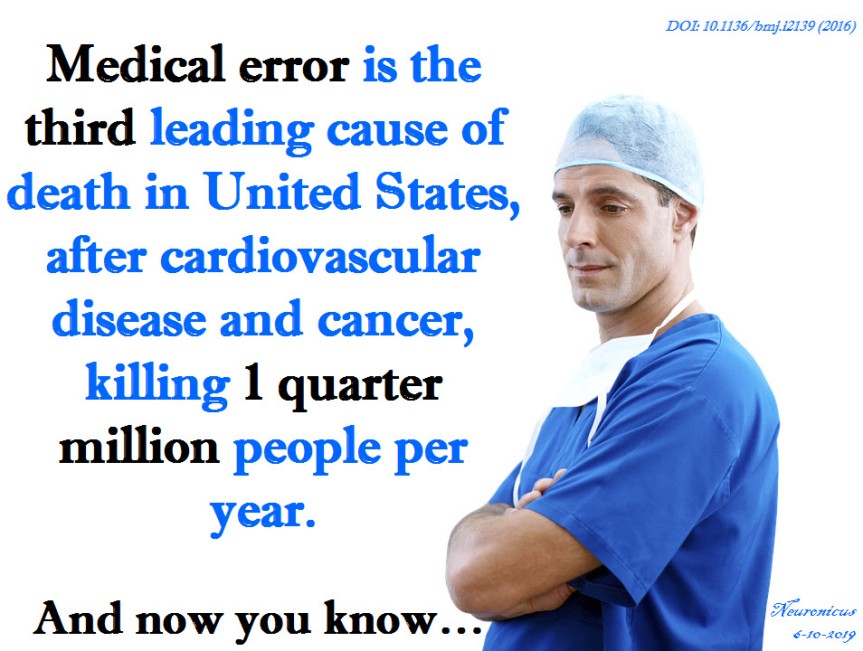
The authors define medical error as “death due to
1) an error in judgment, skill, or coordination of care,
2) a diagnostic error,
3) a system defect resulting in death or a failure to rescue a patient from death, or
4) a preventable adverse event.” (Letter to CDC by Makary et al., 2016)
I reproduced the authors’ definition because there is a hot debate in the medicine field as to what constitutes a medical error and what is preventable vs. unpreventable. It might seem clear cut to you and me, but after I perused a few papers from both sides I must admit that things seem (a bit) more complicated than I thought. Personally, I’m all onboard with the above definition.
Also, there is an ongoing fight about the actual number of deaths attributable to medical errors. I don’t have the time to read or get into that fight. So I’ll ask only one question: does it matter if the number is in the hundreds of thousands or merely tens of thousands? No, it doesn’t; medical errors need to be tackled head on, no matter how many people they kill. There will always be victims because doctors are humans and they make mistakes, like everybody else. But that doesn’t mean that they and their hospitals shouldn’t be held accountable. We, as patients, children and parents of patients, want that number to be as small as possible, is as simple as that. If the processes and methods of counting, assessing, and judging medical errors are kept hidden or worse, buried through misleading or downright false paperwork, then how can we trust the judgment of medical professionals? The authors’ letter to CDC attempts to do just that: by getting the hospitals to acknowledge medical errors on death certificates, the issue is becoming more visible. Where there is visibility and transparency, programs can then be implemented to reduce those numbers, whatever they may be.
Actually, the fact that the number of deaths attributable to medical error is disputable is a case in point; if there was a clear definition of what medical error is and a clear way of tracking it, then we would have a starting point on how to reduce its occurrence. And that’s why I will leave my picture where it is: to support the conversation around the need to better track medical error.
P.S.1 A newer paper, Stockwell et al. (2018) found that 10 % of the pediatric admissions in US hospitals end up with preventable adverse effects, most frequently as a result of hospital-acquired infections, followed by intravenous line complications, gastrointestinal harms, respiratory-related harms, and other causes (p. 4). The more worrisome fact is that this percentage is unchanged, at least between 2007 and 2012.
P.S.2 Just to make it clear, I will always go to doctors with an MD after their name, even if they make mistakes, because they give me and my loved ones the best chance of healing and survival. Calling out that there is more work to be done to improve our safety, particularity in the washing hands department (can’t believe this is still a thing!), doesn’t mean that I will go in the cuckoo land of homeopathy, chiropracty, and other “alternative” medicine.
REFERENCES:
- Makary MA, & Daniel M. (3 May 2016). Medical error – the third leading cause of death in the US. BMJ, 353:i2139. doi: 10.1136/bmj.i2139, PMID: 27143499. ARTICLE | NPR cover
- Joo S, Daniel M, Xu T, & Makary, MA (1 May 2016). RE: Methodology used for collecting national health statistics, Open Letter to U.S. Centers for Disease Control and Prevention FREE FULLTEXT PDF
-
Stockwell DC, Landrigan CP, Toomey SL, Loren SS, Jang J, Quinn JA, Ashrafzadeh S, Wang MJ, Wu M, Sharek PJ, Classen DC, Srivastava R, Parry G, Schuster MA; GAPPS Study Group. (Aug 2018, Epub 13 July 2018). Adverse Events in Hospitalized Pediatric Patients. Pediatrics, 2;142(2). pii: e20173360. PMID: 30006445,PMCID: PMC6317760, DOI: 10.1542/peds.2017-3360. ARTICLE | FREE FULLTEXT PDF
By Neuronicus, 13 October 2019

